
This is the first scientifically validated, CE-marked, non-invasive vagal neuromodulation system specifically developed for anxiety regulation—addressing the nervous system dysregulation that keeps you stuck in fight-or-flight mode.
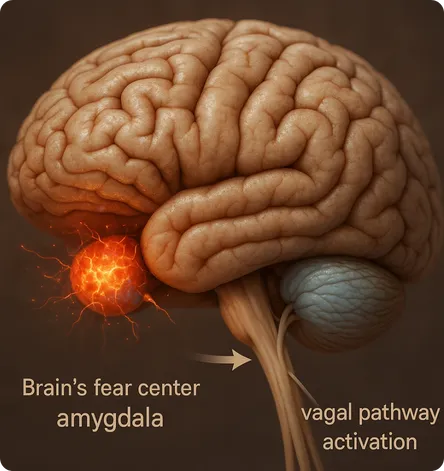
The First Device Validated for Anxiety Reduction Through Nervous System Regulation
Nurosym is the first portable vagus nerve stimulation device with rigorous clinical validation specifically for anxiety reduction. Anxiety disorders fundamentally reflect nervous system dysregulation—your body stuck in fight-or-flight mode even when there’s no real danger.
When your vagus nerve activity is low, your nervous system loses its natural “brake” on the stress response. This leaves you in constant high alert: racing heart, racing thoughts, and an inability to calm down no matter how hard you try.
Unlike anxiety medications that alter brain chemistry or therapy that requires mental effort during peak anxiety, Nurosym directly activates your vagus nerve—restoring the physiological calm-mode activation that anxiety suppresses.
- Validated through 50+ completed research studies and over 4 million user sessions demonstrating significant reductions in validated anxiety assessment scores (BURNS Anxiety Inventory, GAD-7, STAI)
- 35% average reduction in anxiety symptom scores in trials using standardized protocols—without serious adverse events reported in studies to date[1]
- CE Marked medical device certification meeting rigorous safety and effectiveness standards for anxiety regulation
- Studied with Chicago University Medical School, UCLA, and 100+ research institutions establishing the gold standard for non-invasive anxiety intervention
“Among similar wellness devices, it stands out for its strong research foundation and user-friendly design.”
– DEREK, US
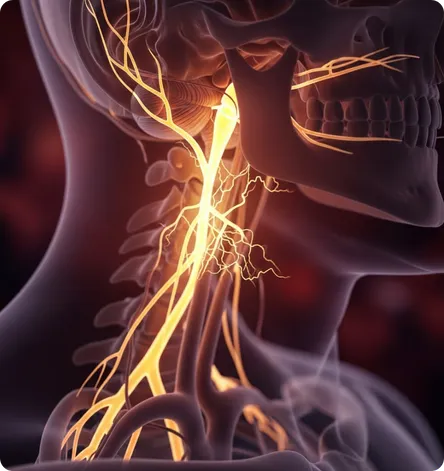
Direct Pathway to Calm Your Fight-or-Flight Response
Your vagus nerve is the main “off switch” for your body’s stress response. When it’s active, it sends calming signals that slow your heart rate, deepen your breathing, relax your muscles, and tell your brain that you’re safe.
In anxiety disorders, this vagal “brake” isn’t working properly. Your stress system activates too easily and stays activated too long. Even when you consciously know there’s no danger, your body keeps responding as if there is.
Nurosym delivers precisely calibrated electrical signals to your vagus nerve through your ear. This directly activates the neural pathway that shifts your nervous system from fight-or-flight mode to rest-and-digest mode—without requiring conscious effort.
- Activates your body's natural calming system sending immediate parasympathetic signals through vagal pathways to your heart, lungs, and digestive system
- Works at the brainstem level modulating the primary stress control centers before anxiety signals reach conscious awareness
- Doesn't require mental effort unlike breathing exercises or meditation—works even when your mind is too anxious to focus
- Produces measurable physiological calming observable through reduced heart rate, increased heart rate variability, and normalized stress hormone patterns
“It helps me achieve a state of tranquility similar to meditation. The shift is subtle, but I notice feeling more at ease.”
– TOM, UK
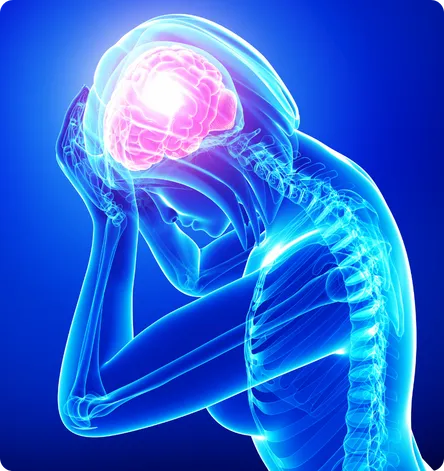
To Reduce Overactivation of Your Brain’s Fear Center
Anxiety disorders involve hyperreactivity of the amygdala—your brain’s fear and threat-detection center. In anxiety, your amygdala overreacts to minor stressors, perceiving threats that aren’t really there and triggering intense fear responses to everyday situations.
This amygdala hyperactivity creates the constant sense of danger, the racing heart before presentations, the panic in crowded spaces, and the fear that something terrible is about to happen. It’s not that you’re choosing to feel anxious—your fear center is genuinely overactivated.
Your vagus nerve has direct connections to the amygdala and sends calming signals that reduce its reactivity. Vagal stimulation helps quiet this overactive fear response, making your brain less likely to trigger false alarms.
- Reduces stress-induced amygdala activation through enhanced vagal signaling to anxiety-regulatory brain regions, documented via brain imaging studies
- Decreases threat perception and fear conditioning by strengthening the communication between your rational brain (prefrontal cortex) and emotional brain (amygdala)
- Helps break the anxiety-anxiety cycle where fear of anxiety itself triggers more anxiety by reducing the baseline reactivity that makes you hypervigilant
- Produces measurable reductions in anxiety-center overactivation corresponding to decreased rumination, improved emotional regulation, and reduced anticipatory anxiety
“Because … of my workplace, because of really high stress … I got severe reflux. The constant push to deliver more work destroyed my organism. Each time I was putting the device I could release tension from my nervous system.”
– JAKUB, UK

Helps Interrupt the Panic Spiral Before It Peaks.
Panic attacks represent extreme activation of your fight-or-flight system—your body flooding with stress hormones, heart racing, difficulty breathing, chest tightness, and overwhelming fear. During panic, your sympathetic nervous system is in full activation while your parasympathetic (calming) system is completely suppressed.
The fear of having another panic attack often creates a vicious cycle: anxiety about panic triggers more panic. This anticipatory anxiety keeps your nervous system primed for the next attack, making attacks more frequent.
Vagal stimulation addresses both acute panic and the underlying nervous system sensitivity that makes you prone to attacks. By strengthening your vagal “brake,” you become less reactive to the internal sensations that typically trigger panic.
- Strengthens parasympathetic nervous system response providing stronger physiological opposition to panic-inducing sympathetic surges
- Reduces baseline anxiety sensitivity making you less likely to misinterpret normal body sensations (increased heart rate, breathing changes) as dangerous
- Can be used during or after panic episodes to accelerate recovery and return to calm baseline
- Helps you regain control faster, especially in the early stages of a panic surge
“When I wasn’t getting enough deep, restorative sleep, it impacted my mood and daily routine. Nurosym has completely transformed the way I rest.”
– DANIEL, WALES

To Address Physical Anxiety Symptoms Directly
Anxiety isn’t just mental—it creates intense physical symptoms. Racing heart, chest tightness, difficulty breathing, muscle tension, stomach problems, dizziness, and sweating are all driven by your overactive stress response. Often these physical symptoms are more distressing than the worried thoughts.
Many people with anxiety fear these physical symptoms mean something is medically wrong with their heart, lungs, or digestive system. Medical tests come back normal because the problem isn’t organ damage—it’s nervous system dysregulation.
Vagal stimulation directly addresses these physical symptoms by activating the parasympathetic pathways that control heart rate, breathing, digestion, and muscle tension. This creates measurable physiological changes you can feel.
- Reduces resting heart rate and heart rate reactivity through direct vagal influence on your heart's pacemaker cells
- Improves breathing patterns by activating parasympathetic control of respiratory rhythm, reducing the shallow, rapid breathing characteristic of anxiety
- Releases muscle tension through nervous system relaxation rather than requiring conscious effort to "relax"
- Normalizes digestive function restoring vagal control of gut motility and secretions disrupted by chronic anxiety activation
- Creates tangible physical calm you can feel in your body—not just a mental state but actual physiological change
“Honestly, I’ve noticed such a positive change. I have far fewer days where I feel too drained to keep up with my daily routine.”
– FRANCESCA, UK
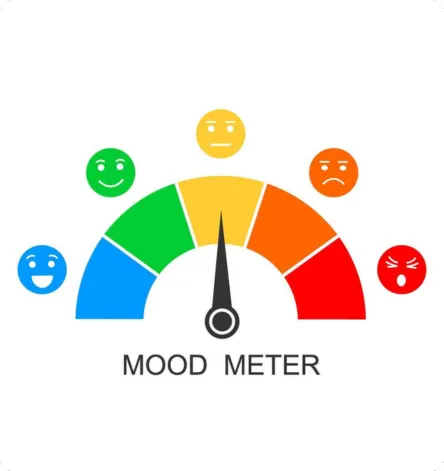
For Improved Emotional Regulation and Reduced Reactivity
Anxiety makes you emotionally reactive—small stressors trigger big responses, minor setbacks feel catastrophic, and you can’t “just let things go.” This emotional dysregulation stems from impaired communication between your emotional brain (amygdala and limbic system) and your rational brain (prefrontal cortex).
When your vagal tone is low, your prefrontal cortex loses its ability to regulate emotional responses. Your emotional brain takes over, leaving you feeling out of control, overreacting to situations, and struggling to calm yourself down even when you know you’re overreacting.
Vagal stimulation enhances the prefrontal cortex’s regulatory control over emotional centers, giving you more emotional flexibility and resilience. This doesn’t eliminate emotions—it restores your ability to respond proportionally rather than explosively.
- Strengthens prefrontal-amygdala communication enhancing your brain's natural emotional regulation circuits
- Reduces emotional reactivity to triggers making you less likely to spiral into anxiety over minor stressors
- Improves distress tolerance increasing your capacity to experience uncomfortable emotions without becoming overwhelmed
- Enhances cognitive control over worry making it easier to redirect attention away from anxious thoughts when needed
- Creates space between stimulus and response giving you more choice in how you react rather than automatic anxiety activation
“Since I started using it, I’ve noticed a significant improvement in how I feel overall. It’s been three months now, and I’m hopeful for even more positive changes—it’s definitely a step in the right direction.”
– TERRY, UK

To Break the Anxiety-Insomnia Cycle
Anxiety and insomnia create a vicious cycle: anxiety prevents sleep (racing thoughts, physical tension, hypervigilance), while sleep deprivation worsens anxiety by impairing emotional regulation and increasing stress reactivity. Each feeds the other, progressively worsening both conditions.
Pre-sleep anxiety—worrying about not falling asleep, mentally reviewing the day, or anticipating tomorrow’s stressors—reflects sustained sympathetic activation when your body should be shifting into parasympathetic sleep-mode. Your nervous system can’t make this transition naturally.
Vagal stimulation facilitates the autonomic shift necessary for sleep initiation while addressing the underlying anxiety that prevents sleep. This breaks the cycle by improving both conditions simultaneously.
- Accelerates the nervous system shift from waking to sleep mode by enhancing parasympathetic activation during the critical pre-sleep period
- Reduces pre-sleep cognitive arousal quieting racing thoughts and worry that typically delay sleep onset
- Improves sleep quality and architecture resulting in more restorative sleep that enhances next-day anxiety resilience
- 31% improvement in sleep quality scores with corresponding reductions in anxiety symptoms as better sleep restores emotional regulation capacity[2]
- Creates positive cycle where better sleep reduces anxiety, which further improves sleep quality
“I was looking for a way to better navigate seasonal challenges. I had tried workouts and meditation apps but discovered Nurosym, and I noticed changes within just a couple of weeks. I feel more balanced and better equipped to manage daily pressures.”
– TIJANA, US
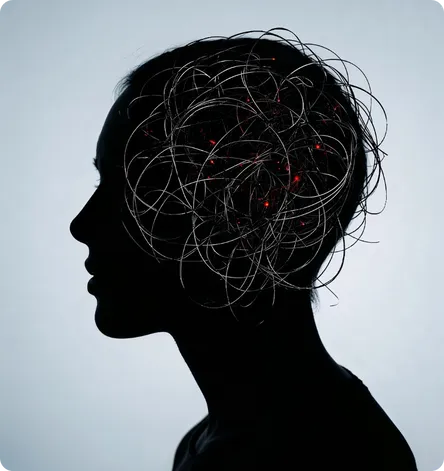
For Reduced Overthinking and Worry Patterns
Overthinking—worrying about future events, catastrophizing potential outcomes, and feeling anxious about feeling anxious—represents a specific pattern of nervous system dysregulation. Your brain gets stuck in threat-scanning mode, constantly anticipating danger.
This chronic worry isn’t a thinking problem you can solve with logic. It’s driven by a hyperactive stress system that keeps your brain in threat-detection mode. When your vagal tone is low, your brain interprets uncertainty as danger and generates worst-case scenarios.
Improving vagal function shifts your nervous system’s baseline state from threat-oriented to safety-oriented. This doesn’t eliminate appropriate concern about real challenges—it reduces the constant low-grade anxiety about things that might never happen.
- Reduces baseline threat-detection sensitivity making your nervous system less likely to interpret ambiguous situations as dangerous
- Decreases rumination and repetitive worry by shifting brain activity away from anxious thought loops
- Improves capacity to tolerate uncertainty reducing the need to control or predict everything as a way to feel safe
- Dampens the anxiety-about-anxiety pattern where fear of future anxiety creates present anxiety
- Creates more neutral baseline emotional state making it easier to engage with present moment rather than future worries
“I’ve noticed improved recovery indicators tracked by my fitness device and a greater ability to stay focused or train for extended periods.”
– HENRY, UK

As Non-Pharmaceutical Alternative to Anxiolytic Medications
Standard pharmaceutical therapy for generalized anxiety typically involves SSRIs, SNRIs, benzodiazepines, or buspirone. While effective for some, these medications come with significant challenges: SSRIs cause sexual dysfunction in 40-65% of users, weight gain, emotional blunting, and difficult discontinuation. Benzodiazepines risk dependency, cognitive impairment, and dangerous withdrawal.
Many individuals seek anxiety relief without chronic medication exposure—whether due to intolerable systemic effects, philosophical preference for non-pharmaceutical approaches, concerns about long-term brain chemistry alteration, or ineffectiveness of medications tried.
Vagal neuromodulation delivers anxiety reduction through direct nervous system regulation—activating your body’s natural calming pathways—rather than altering neurotransmitter concentrations with synthetic compounds.
- Does not have the same systemic effects as medication, such as sexual dysfunction, weight gain, emotional numbing, cognitive fog, and physical dependency
- Works through your body's natural regulatory systems enhancing existing calming pathways rather than introducing foreign chemicals
- No withdrawal or discontinuation syndrome you can stop using the device without tapering or rebound anxiety
- Can be used alongside therapy providing physiological regulation that makes psychological interventions more effective
“Sometimes I’ll put it on while reading, and I find it helps me stay focused, even on more challenging pieces of writing.”
– YVONNE, UK
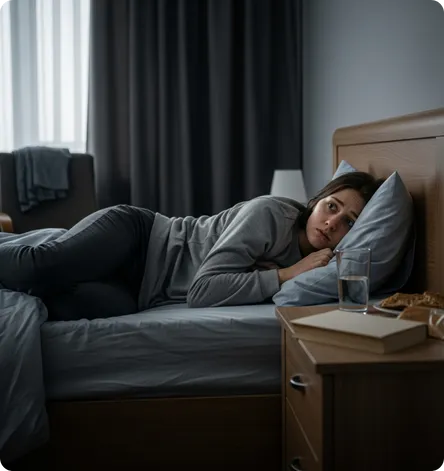
For Treatment-Resistant or Medication-Intolerant Individuals
Treatment-resistant anxiety—insufficient improvement despite trying multiple evidence-based treatments—affects approximately 30-40% of individuals with generalized anxiety disorder. Some people don’t respond adequately to SSRIs or therapy. Others experience intolerable systemic effects that force medication discontinuation.
Additionally, certain individuals have medical contraindications to standard anxiety medications (pregnancy, breastfeeding, certain health conditions, medication interactions), leaving them without conventional treatment options.
Vagal neuromodulation offers a fundamentally different mechanism—direct autonomic nervous system modulation rather than neurotransmitter-based intervention—providing a new pathway for those who haven’t responded to conventional approaches.
- Different mechanism from medications and therapy offering hope for those who haven't responded to neurotransmitter-based interventions
- Validated in real-world clinical settings with users reporting clinically meaningful anxiety reduction
- Can be used when medications are contraindicated providing safe option during, breastfeeding, or with certain medical conditions (always consult healthcare provider)
- Addresses autonomic nervous system directly targeting the physiological substrate that may not respond to cognitive or pharmaceutical interventions alone
- Works as adjunctive or standalone solution complementing existing therapy or providing alternative when other options have failed
“I often deal with tension at night that affects my face and head, but I started to notice a difference—it’s been a positive shift, even in how I feel physically.”
– HOGAN, US

To Complement Therapy With Physiological Regulation
Cognitive-behavioral therapy (CBT) and other evidence-based therapies are highly effective for anxiety—but they require cognitive capacity and emotional regulation ability that anxiety itself often impairs. During high anxiety, your prefrontal cortex (rational brain) is partially shut down, making it difficult to apply therapeutic skills.
Many therapists recognize that anxiety has both psychological and physiological components. Addressing anxious thoughts without addressing the dysregulated nervous system producing physical anxiety symptoms often yields incomplete results.
Vagal stimulation provides the physiological regulation that makes therapy more effective. By calming your nervous system, you create the conditions where therapeutic techniques can actually work.
- Reduces baseline physiological arousal creating better conditions for cognitive work and therapeutic skill application
- Enhances capacity to engage with therapy by providing enough calm to access rational thinking during sessions
- Makes therapeutic techniques more accessible when you need them most—your nervous system is calm enough to remember and apply CBT skills
- Addresses the physiological component that talk therapy alone may not fully reach
- Creates synergistic effects where improved nervous system function enhances therapy outcomes, and therapy skills help maintain improved function
- Recommended by mental health professionals as complementary tool that enhances overall treatment effectiveness
“I was told by a professional that they weren’t sure what was causing my challenges, but a long-term approach was suggested. I started researching ways to support myself and discovered Nurosym.”
– TREVOR, UK

To Reduce Avoidance Patterns Like Social Anxiety and Procrastination
Social anxiety and procrastination are often misunderstood as personality problems, being “too shy,” “not confident enough,” or “lazy.”
In reality, both are physiological anxiety responses driven by the same mechanism: your nervous system interprets certain situations as threats, triggering a stress response that makes you want to avoid them.
When vagal tone is low, the amygdala (your brain’s fear center) reacts too strongly to situations involving uncertainty, evaluation, or potential judgment. Your prefrontal cortex—the part that normally keeps things in perspective—gets overridden. The result is avoidance: not because you don’t want to act, but because your body feels unsafe doing so.
Vagal stimulation strengthens the physiological “brake” on this stress response, reducing the internal alarm signals that make everyday tasks and interactions feel overwhelming.
- Reduces threat reactivity in the amygdala, making social situations feel less intense
- Enhances prefrontal control, improving your ability to initiate tasks without panic or avoidance
- Decreases the physical discomfort (heart racing, tight chest, tension) that drives avoidance behaviors
- Helps you engage — even when something feels emotionally charged or vulnerable
This isn’t about forcing confidence or motivation.
It’s about changing the physiological state that makes avoidance feel necessary in the first place.
The Mechanism: How VNS Regulates Anxiety
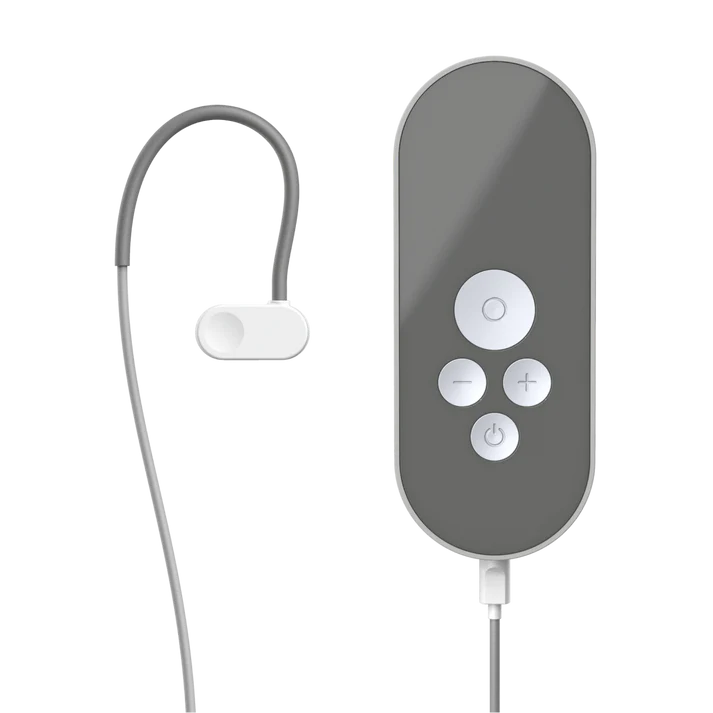
Auricular Vagal Neuromodulation Therapy (AVNT™) — Nurosym’s proprietary protocol developed with Chicago University Medical School, UCLA, Imperial College London, and 60+ research institutions, specifically validated for anxiety regulation across 4+ million supervised sessions.
How It Works:
Anxiety disorders fundamentally involve your nervous system stuck in fight-or-flight mode with insufficient calming (parasympathetic) system activation. Your vagus nerve is the primary pathway that activates your body’s natural calm-mode response.
Nurosym delivers precisely calibrated electrical signals to your vagus nerve through your ear, activating the pathways that shift your nervous system from anxiety to calm:
- Peripheral Activation: Electrical stimulation activates vagal nerve fibers in your ear’s cymbal conchae—the optimal non-invasive access point
- Brainstem Transmission: Signals travel to the nucleus tractus solitarius (NTS)—your brain’s primary stress and emotion regulation center
- Anxiety-Regulatory Network Activation: The NTS connects to key structures that control anxiety:
- Locus coeruleus — regulates arousal, threat perception, and fight-or-flight activation
- Amygdala — your fear center; vagal signals reduce its overreactivity to perceived threats
- Prefrontal cortex — enhances rational brain's control over emotional reactions
- Hypothalamus — reduces stress hormone (cortisol) production and release
- Parasympathetic Activation: Enhanced “rest-and-digest” system activity throughout your body—slowing heart rate, deepening breathing, releasing muscle tension
- Neurotransmitter Normalization: Balances norepinephrine (arousal), serotonin (mood), and GABA (calming) naturally through improved nervous system function
- Stress Hormone Regulation: Normalizes cortisol patterns and reduces chronic stress hormone elevation that perpetuates anxiety
Clinical Outcome: Multi-level intervention that addresses anxiety at its source—nervous system dysregulation—without requiring conscious effort or pharmaceutical intervention.
Clinical Validation: Anxiety Symptom Reduction
- 35% average reduction in BURNS Anxiety Inventory scores (p<0.001) in intention-to-treat analysis of randomized controlled trials[3]
- Significant reductions across multiple validated anxiety measures including GAD-7 (Generalized Anxiety Disorder scale) and STAI (State-Trait Anxiety Inventory)
- 45% improvement in depression scores and mood as measured by the Beck Depression Inventory within 10 days, with notable improvements appearing as early as 5 days (p<0.05)[4]
Neurobiological Changes:
- Measurable reductions in amygdala overactivation documented via brain imaging studies, corresponding to decreased fear responses
- Improved prefrontal-amygdala connectivity enhancing emotional regulation capacity
- Significantly enhances parasympathetic nervous system function with measurable changes in heart rate variability markers appearing within one hour (p=0.002)[5]
- Normalized stress hormone patterns with improved cortisol rhythm and reduced baseline stress hormone elevation
Physical Symptom Improvement:
- Reduced resting heart rate and decreased heart rate reactivity to stressors
- Improved heart rate variability indicating better stress resilience and autonomic balance
- Decreased physical tension and stress-related somatic symptoms
- Significantly improved sleep quality (31% improvement in validated sleep assessments over 4 weeks) breaking the anxiety-insomnia cycle
Comorbid Symptom Improvements:
- Significant mood improvements in individuals with anxiety and depression, with clinical studies demonstrating 35% reduction in anxiety symptoms and 45% improvement in depression scores using validated psychological assessments
- Reduced fatigue (48% reduction) as anxiety-related exhaustion improves[6]
- Improved digestive function as gut-brain axis dysregulation normalizes
Real-World Effectiveness:
- Over 4 million supervised clinical sessions completed across research and clinical settings
- Users reporting clinically meaningful improvements in anxiety symptoms, stress resilience, or quality of life
- High adherence rates as users experience tangible benefits
- Favorable safety profile with no serious adverse events and no systemic effects typical of anxiolytic medications
Clinical Significance:
For individuals experiencing generalized anxiety, panic disorder, or chronic worry, Nurosym represents a scientifically validated intervention that addresses anxiety at its physiological source—activating the nervous system pathways that regulate stress and emotional balance.
Calm your nervous system. Reduce anxiety naturally. Reclaim the peace you deserve.
Nurosym is a CE-marked Class IIa medical device. Clinical outcomes represent average results from controlled studies and real-world effectiveness analyses. Individual responses vary. The device is intended for general wellness and stress management; it is not intended to diagnose, treat, cure, or prevent any disease. Anxiety disorders should be evaluated by qualified healthcare professionals. Users with pacemakers, epilepsy, or other significant medical conditions should consult healthcare providers before use. Nurosym is not a replacement for professional mental health treatment and should be used as part of a comprehensive approach to anxiety management.
Resources:
Auricular Vagal Neuromodulation Therapy (AVNT) — Anxiety Symptoms Reduction in Long-COVID Patients, Nurosym Ltd. The study reports significant reductions in anxiety symptoms in individuals with Long-COVID following AVNT intervention. Available at: https://nurosym.org/fr/pages/anxiety-symptoms-reduction-in-long-covid-patients-after-auricular-vagal-neuromodulation-therapy
- Auricular Vagal Neuromodulation Therapy (AVNT) Pilot Study on Long COVID-related Sleep Quality, Nurosym Ltd. This single-group assignment trial reported significant improvement in sleep disturbance score (PSQI) following auricular VNS in individuals with post-viral syndrome. Available at: https://nurosym.org/fr/pages/auricular-vagal-neuromodulation-therapy-improves-sleep-score-in-long-covid-a-pilot-study
- Auricular Vagal Neuromodulation Therapy (AVNT) — Anxiety Symptoms Reduction in Long COVID Patients after Auricular Vagal Neuromodulation Therapy, Nurosym Ltd.. The study reports a significant and sustained reduction in anxiety scores in patients with Long COVID following a 10-day at-home AVNT protocol. Available at: https://nurosym.org/fr/pages/anxiety-symptoms-reduction-in-long-covid-patients-after-auricular-vagal-neuromodulation-therapy
Auricular Vagal Neuromodulation Therapy (AVNT) — Anxiety Symptoms Reduction in Long COVID Patients after Auricular Vagal Neuromodulation Therapy, Nurosym Ltd.. The study reports a significant and sustained reduction in anxiety scores in patients with Long COVID following a 10-day at-home AVNT protocol. Available at: https://nurosym.org/fr/pages/anxiety-symptoms-reduction-in-long-covid-patients-after-auricular-vagal-neuromodulation-therapy
Auricular Vagal Neuromodulation Therapy (AVNT) — Significantly Increases Vagus Nerve Activity and Heart-Rate Variability in Healthy Subjects (Randomised Placebo-Controlled Study), Nurosym Ltd. The two-stage cross-over trial found a ~61% increase in high-frequency HRV (indicative of parasympathetic/vagal activity) compared with sham (p < 0.0017). Available at: https://nurosym.org/fr/pages/auricular-vagal-neuromodulation-therapy-avnt-significantly-increases-vagus-nerve-activity-and-heart-rate-variability-in-healthy-subjects-randomised-placebo-controlled-study
Auricular Vagal Neuromodulation Therapy (AVNT) — Reduces Fatigue in One-Group Assignment in Post-Viral Syndrome Patients, Nurosym Ltd.. The 10-day, daily 35-minute session treatment in patients with post-viral fatigue reported an approximate 48% improvement in fatigue scores (Pichot Fatigue Scale) from day 0 to day 10 (p < 0.0001). Available at: https://nurosym.org/fr/pages/auricular-vagal-neuromodulation-therapy-avnt-reduces-fatigue-in-one-group-assignment-in-post-viral-syndrome-patients
Share via:


